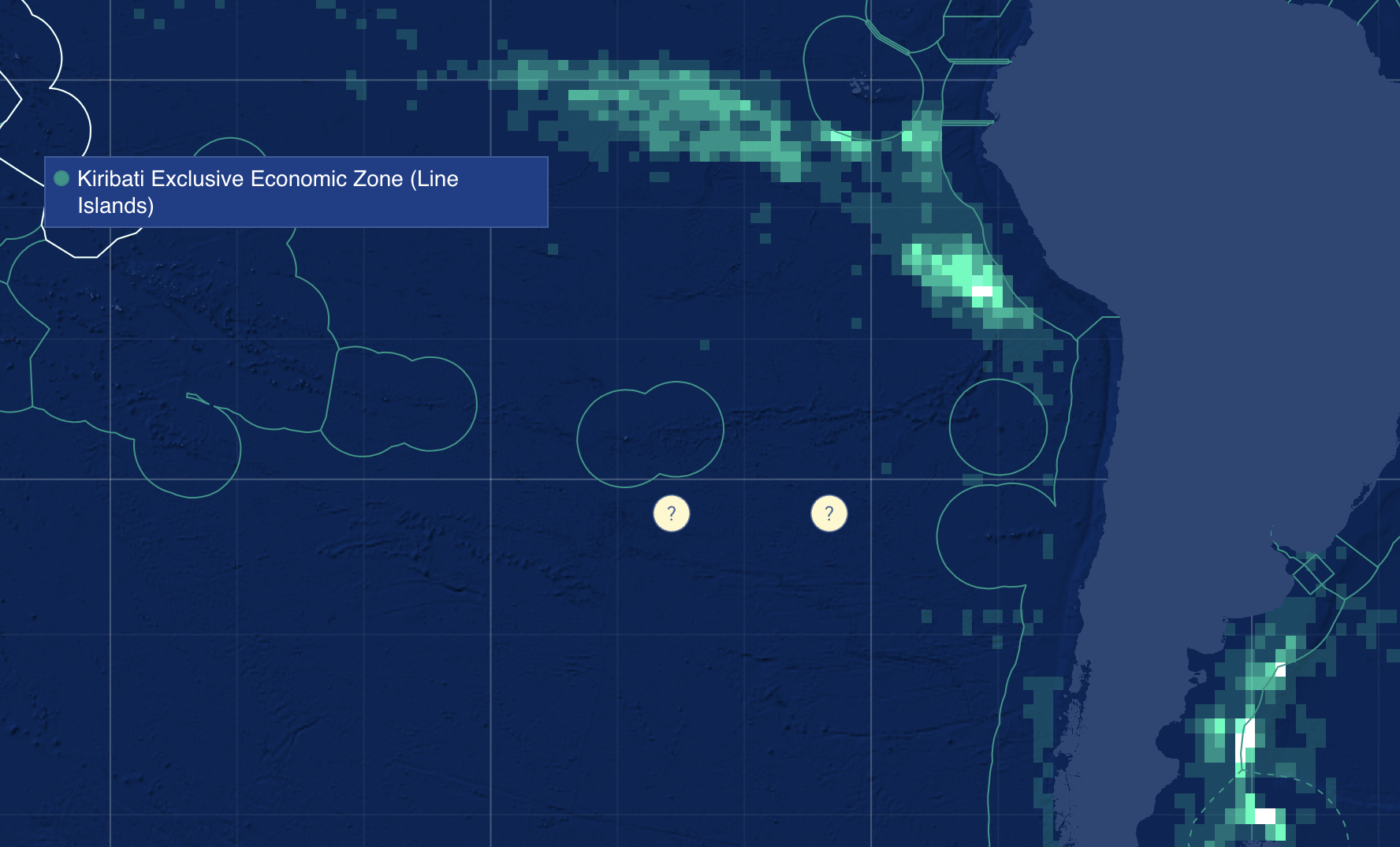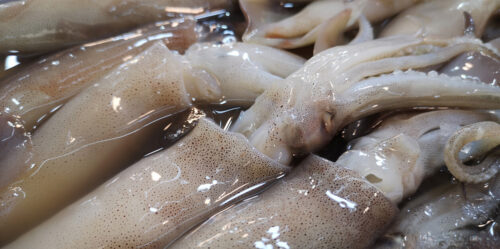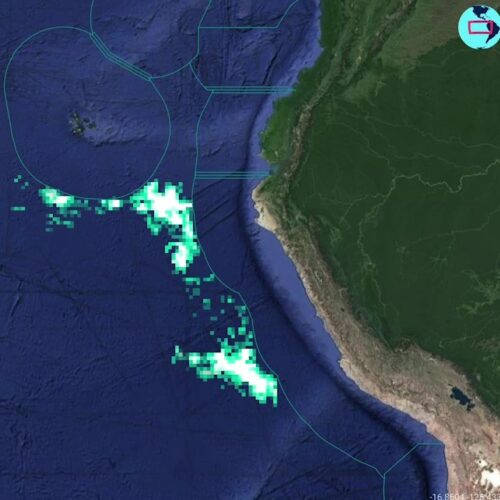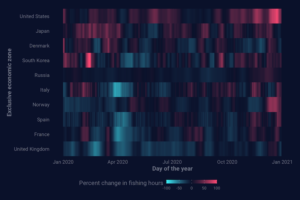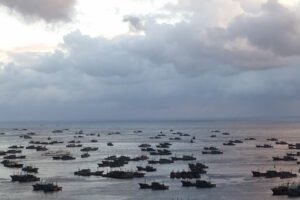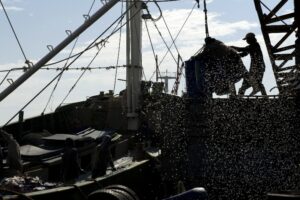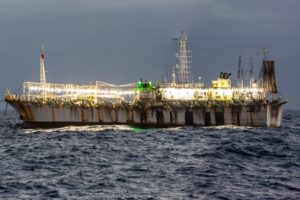Waters off the western coast of South America are home to a high-profile fishery that attracts both local coastal fishers as well as distant water fleets: the jumbo squid.
The jumbo squid (Dosidicus gigas) is the most abundant cephalopod species in the Southeast Pacific Ocean, ranging from the North American coast to southern Chile. This elusive creature reaches up to 3 meters in length and weighs up to 50 kilograms.
Effective monitoring is vital for the sustainable management of jumbo squid. Transparency around vessel information can help drive more informed and equitable fishing policies, and it can also help identify risks of noncompliance.
Global Fishing Watch harnesses cutting-edge technology to analyze the jumbo squid fishery in the Southeast Pacific Ocean, aiming to support monitoring, control, and surveillance efforts and better understand the fleets’ behaviors and footprint.
Our analysis of the 2020 and 2021 squid seasons reveal the true scope of fishing activity in the Pacific waters off South America.
Key Findings From the 2020 and 2021 Squid Seasons
- There were 88 fewer fishing vessels in 2021, but they had greater fishing effort, with an additional 3,543 fishing days.
- The fleet showed fewer automatic identification system (AIS) irregularities in 2021 versus 2020.
- In 2021, the distant water fleet maintained a longer distance from exclusive economic zones (EEZ) of Ecuador (Galápagos) and Peru, reducing suspicions about their possible entry into EEZs.
| 2020 | 2021 | 2022 | |
|---|---|---|---|
| Number of vessels (distant water fleet) | 615 squid fishing vessels. 59 support vessels (carrier and tanker) |
527 squid fishing vessels. 46 support vessels (carrier and tanker) |
447 squid fishing vessels. 63 support vessels (carrier and tanker) |
| Vessel's flag | 96.2% flagged to China. Other vessels were flagged to Chinese Taipei and the Republic of Korea |
98.7% flagged to China. Other vessels were flagged to Chinese Taipei and the Republic of Korea |
99.3% flagged to China. 3 vessels with unknown identity |
| Fishing days | ~95,000 | ~98,543 | ~83,043 |
| Carrier vessel encounter events | 1,519 encounters | 2,511 encounters | 3,006 encounters |
| Carrier vessel loitering events | 4,683 loitering events | 3,792 loitering events | 1,436 loitering events |
| Port visits by fishing vessels to Latin America ports | 19 port visits by 13 vessels to Chimbote and Callao ports |
3 port visits by 2 vessels to Callao |
26 port visits |
| Closest distance from Ecuador’s EEZ (Galápagos) | 0 nautical miles | 150 nautical miles | 200 nautical miles |
Transparency can help create a more accurate global picture of apparent fishing effort to support scientific research on stock health and distributions. With the right information, we can accelerate science and help drive fairer, smarter policies that protect fisheries and those whose livelihoods depend on them.
Frequently Asked Questions
Find answers to the most common questions about squid fishing, the scope and main findings of our reports, and how we get the information and reach our conclusions.
Global Fishing Watch’s algorithm detects apparent fishing activity—however, it does not determine whether the activity is legal or illegal. When we encounter a risk of noncompliance with regulations, we bring this information to relevant government authorities and regional fisheries bodies for further investigation.
For example, our algorithm might indicate that there is apparent fishing activity taking place within a certain area where fishing is prohibited or being conducted with a specific gear type that is restricted. Once this information is sent along, it is then up to the government with jurisdiction to investigate the activity and go on to take appropriate action if something illegal is taking place.
Our 2020 squid analysis was able to detect three types of irregularities:
- Transmission of false positions using automatic identification systems
- Multiple Maritime Mobile Service Identity numbers used for a single vessel
- Shared Maritime Mobile Service Identity numbers across multiple vessels
- Panama: Global Fishing Watch supports Panama in monitoring support vessels operating within the SPRFMO convention area and helps identify potential unauthorized transshipments.
- Ecuador: Global Fishing Watch supports Ecuador in monitoring squid fleet activity taking place off of Ecuadorian waters, and helps identify potential unauthorized fishing activities occurring in its national waters.
- Peru: Global Fishing Watch supports Peru in monitoring squid fleet activity off of Peruvian waters, and helps identify potential unauthorized fishing activities occurring in its national waters.
- Chile: Global Fishing Watch supports Chile in monitoring squid fleet activity off of Chilean waters, and helps identify potential unauthorized fishing activities occurring in its national waters.
Based on the analyses conducted, there is a discrepancy between what we are seeing and what is listed in SPRFMO’s authorized list of vessels. While these differences indicate a potential risk of unreported fishing activity in the SPRFMO squid fishery, we are not in a position to determine whether this is the result of the flag State’s reporting schedule or if vessels are simply not reporting to the flag State.
Global Fishing Watch analyses seek to understand the footprint and behavior of the Southeast Pacific squid fleet, as well as the potential risks of illegal, unreported and unregulated fishing. Estimates about volume of squid caught are not incorporated in que squid fishing analysis. Statistics on squid catch are reported by SPRFMO on an annual basis. One report from SPRFMO shows that the high seas distant water fishing capacity has increased rapidly over time but the catch rates have not increased.
South Pacific Regional Fisheries Management Organization (SPRFMO) records show a very rapid increase in jumbo squid fishing taking place in waters off of South America over the past two decades. According to SPRFMO, the fleet has grown from six vessels in 1990 to 528 in 2019. SPRFMO members and cooperating or non-contracting parties reported 522 squid vessels that were active inside the convention area in 2020. Over 10% (82) of the vessels identified as active by AIS could not be matched to this list, highlighting a potential risk that the catch from these vessels went unreported. The SPRFMO list of active vessels for 2021 isn’t available yet, so AIS data analysis could not be conducted at the moment.
The 2021 season shows a different temporal and spatial distribution of the fleet when compared to 2020. During June and July 2021, the fleet operated farther west than where it was during the same period in 2020. In addition, from August to September the fleet was mostly situated at an average distance of 150 nautical miles off of Galápagos and Ecuador and 100 nautical miles off Peru’s EEZ, while in 2020 the fleet was close to the exclusive economic zones boundary.
Compared to the 2020 season, the distant water squid fleet reduced the number of active vessels in the area of interest by 14% and stayed away from the edges of the EEZs at an average distance of 100 nautical miles. The number of vessels with irregularities in the use of AIS decreased by 3%.
We saw significant discrepancies between the fishing and carrier vessels operating on AIS and what was reported by the flag States as “active vessels.” The differences in numbers indicate a possible risk of unreported fishing, which SPRFMO has defined as illegal, unreported and unregulated activity. We hope SPRFMO members will use the AIS data to validate what is being reported to them by their vessels and take action to identify any unreported activity.
Ensuring that all vessels in operation are both authorized and reporting catch, and that transshipments are in line with SPRFMO’s conservation management measures, can help improve the monitoring, control and management of the jumbo squid fishery. This will also help align the true fishing effort with best available stock assessments. We recommend that coastal States in the region, following the mandate available from SPRFMO, have an enforcement presence on the high seas and conduct at sea boardings.
We continue to monitor this area to understand the fleet’s behavior, especially now that the area is closed, which will remain until November. Historically speaking, during the period, AIS indicates that only one year (2018) had any significant fishing inside this area before the closure came into place.

